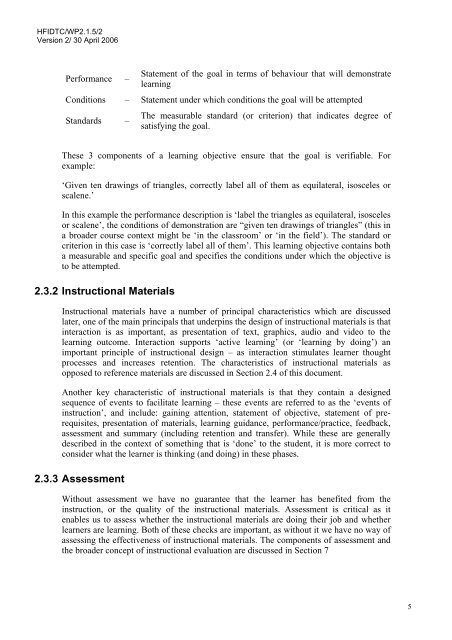E-learning Instructional Design Guidelines - Human Factors ...
E-learning Instructional Design Guidelines - Human Factors ...
E-learning Instructional Design Guidelines - Human Factors ...
Create successful ePaper yourself
Turn your PDF publications into a flip-book with our unique Google optimized e-Paper software.
HFIDTC/WP2.1.5/2<br />
Version 2/ 30 April 2006<br />
Performance –<br />
Statement of the goal in terms of behaviour that will demonstrate<br />
<strong>learning</strong><br />
Conditions – Statement under which conditions the goal will be attempted<br />
Standards –<br />
The measurable standard (or criterion) that indicates degree of<br />
satisfying the goal.<br />
These 3 components of a <strong>learning</strong> objective ensure that the goal is verifiable. For<br />
example:<br />
‘Given ten drawings of triangles, correctly label all of them as equilateral, isosceles or<br />
scalene.’<br />
In this example the performance description is ‘label the triangles as equilateral, isosceles<br />
or scalene’, the conditions of demonstration are “given ten drawings of triangles” (this in<br />
a broader course context might be ‘in the classroom’ or ‘in the field’). The standard or<br />
criterion in this case is ‘correctly label all of them’. This <strong>learning</strong> objective contains both<br />
a measurable and specific goal and specifies the conditions under which the objective is<br />
to be attempted.<br />
2.3.2 <strong>Instructional</strong> Materials<br />
<strong>Instructional</strong> materials have a number of principal characteristics which are discussed<br />
later, one of the main principals that underpins the design of instructional materials is that<br />
interaction is as important, as presentation of text, graphics, audio and video to the<br />
<strong>learning</strong> outcome. Interaction supports ‘active <strong>learning</strong>’ (or ‘<strong>learning</strong> by doing’) an<br />
important principle of instructional design – as interaction stimulates learner thought<br />
processes and increases retention. The characteristics of instructional materials as<br />
opposed to reference materials are discussed in Section 2.4 of this document.<br />
Another key characteristic of instructional materials is that they contain a designed<br />
sequence of events to facilitate <strong>learning</strong> – these events are referred to as the ‘events of<br />
instruction’, and include: gaining attention, statement of objective, statement of prerequisites,<br />
presentation of materials, <strong>learning</strong> guidance, performance/practice, feedback,<br />
assessment and summary (including retention and transfer). While these are generally<br />
described in the context of something that is ‘done’ to the student, it is more correct to<br />
consider what the learner is thinking (and doing) in these phases.<br />
2.3.3 Assessment<br />
Without assessment we have no guarantee that the learner has benefited from the<br />
instruction, or the quality of the instructional materials. Assessment is critical as it<br />
enables us to assess whether the instructional materials are doing their job and whether<br />
learners are <strong>learning</strong>. Both of these checks are important, as without it we have no way of<br />
assessing the effectiveness of instructional materials. The components of assessment and<br />
the broader concept of instructional evaluation are discussed in Section 7<br />
5
















